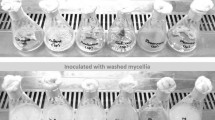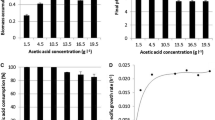Abstract
Hydrolyzates from lignocellulosic biomass contain a mixture of simple sugars; the predominant ones being glucose, cellobiose and xylose. The fermentation of such mixtures to ethanol or other chemicals requires an understanding of how each of these substrates is utilized.Candida lusitaniae can efficiently produce ethanol from both glucose and cellobiose and is an attractive organism for ethanol production. Experiments were performed to obtain kinetic data for ethanol production from glucose, cellobiose and xylose. Various combinations were tested in order to determine kinetic behavior with multiple carbon sources. Glucose was shown to repress the utilization of cellobiose and xylose. However, cellobiose and xylose were simultaneously utilized after glucose depletion. Maximum volumetric ethanol production rates were 0.56, 0.33, and 0.003 g/Lh from glucose, cellobiose and xylose, respectively. A kinetic model based on cAMP mediated catabolite repression was developed. This model adequately described the growth and ethanol production from a mixture of sugars in a batch culture.
Similar content being viewed by others
References
Sun, Y. and J. Cheng (2002) Hydrolysis of lignocellulosic materials for ethanol production: a review.Bioresour. Technol. 83: 1–11
Ojumu, T. V., B. E. AttahDaniel, E. Betiku, and B. O. Solomon (2003) Auto-hydrolysis of lignocellulosics under extremely low sulphuric acid and high temperature conditions in batch reactor.Biotechnol. Bioprocess Eng. 8: 291–293.
Delgenes, J. P., M. C. Escare, J. M. Laplace, R. Moletta, and J. M. Navarro (1998) Biological production of industrial chemicals,i.e. xylitol and ethanol, from lignocelluloses by controlled mixed culture systems.Ind. Crops and Producis 7: 101–111.
Lee, K. (2005) Comparison of fermentative capacities of lactobacilli in single and mixed culture in industrial media.Process Biochem. 40: 1559–1564.
Freer, S. N. and R. W. Detroy (1983) Characterization of cellobiose fermentations to ethanol by yeasts.Biotechnol. Bioeng. 25: 541–548.
Spindler, D. D., C. E. Wyman, K. Grohmann, and G. P. Philippidis (1992) Evaluation of the cellobiose-fermenting yeastBrettamomyces custersii in the simultaneous saccharification and fermentation of cellulose.Biotechnol. Lett. 14: 403–407.
Nakamura, Y. and T. Sawada (2003) Ethanol production from artificial domestic household waste solubilized steam explosion.Biotechnol. Bioprocess Eng. 8: 205–209.
Sanchez, S., V. Bravo, E. Castro, A. J. Moya, and F. Camacho (1999) Comparative study of the fermentation of D-glucose/D-xylose mixtures withPachysolen tannophilus andCandida shehatae.Bioprocess Eng. 21: 525–532.
Kastner, J. R., W. J. Jones, and R. S. Roberts (1999) Ethanol fermentation of mixed-sugars using a two-phase, fedbatch process: method to minimize D-glucose repression ofCandida shehatae D-xylose fermentations.J. Ind. Microbiol. Biotechnol. 22: 65–70.
Imanaka, T. and S. Aiba (1977) A kinetic model of catabolite repression in the dual control mechanism in microorganisms.Biotechnol. Bioeng. 19: 757–764.
Slaff, G. F. and A. E. Humphrey (1986) The growth ofClostridium thermohydrosulfuricum on multiple substrates.Chem. Eng. Commu. 45: 33–43.
Nikolajsen, K., J. Nielsen, and J. Villadsen (1991) Structured modeling of a microbial system: III. Growth on mixed substrates.Biotechnol. Bioeng. 38: 24–29.
Nakamura, Y., T. Sawada, and E. Inoue (2001) Mathematical model for ethanol production from mixed sugars byPichia stipitis.J. Chem. Technol. Biotechnol. 76: 586–592.
Yoon, H., G. Klinzing, and H. W. Blanch (1977) Competition for mixed substrates by microbial populations.Biotechnol. Bioeng. 19: 1193–1210.
Author information
Authors and Affiliations
Corresponding author
Rights and permissions
About this article
Cite this article
Kwon, Y.J., Engler, C.R. Kinetic models for growth and product formation on multiple substrates. Biotechnol. Bioprocess Eng. 10, 587–592 (2005). https://doi.org/10.1007/BF02932299
Received:
Accepted:
Issue Date:
DOI: https://doi.org/10.1007/BF02932299




